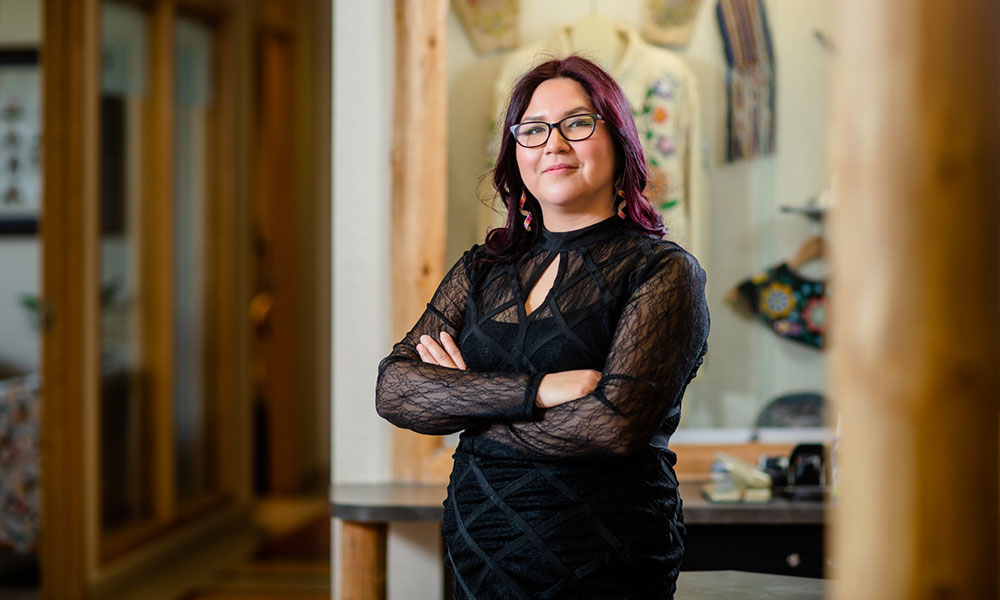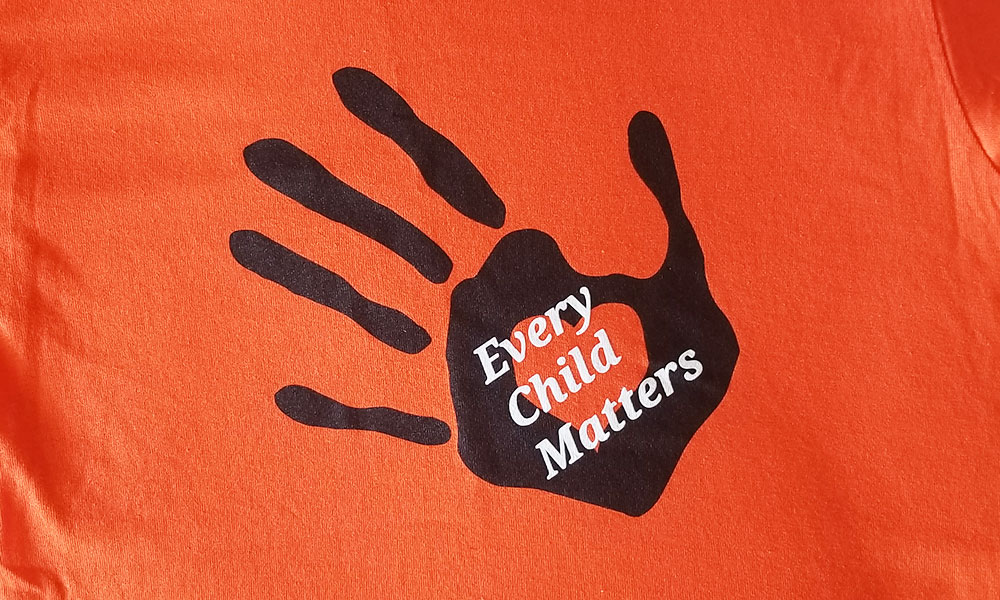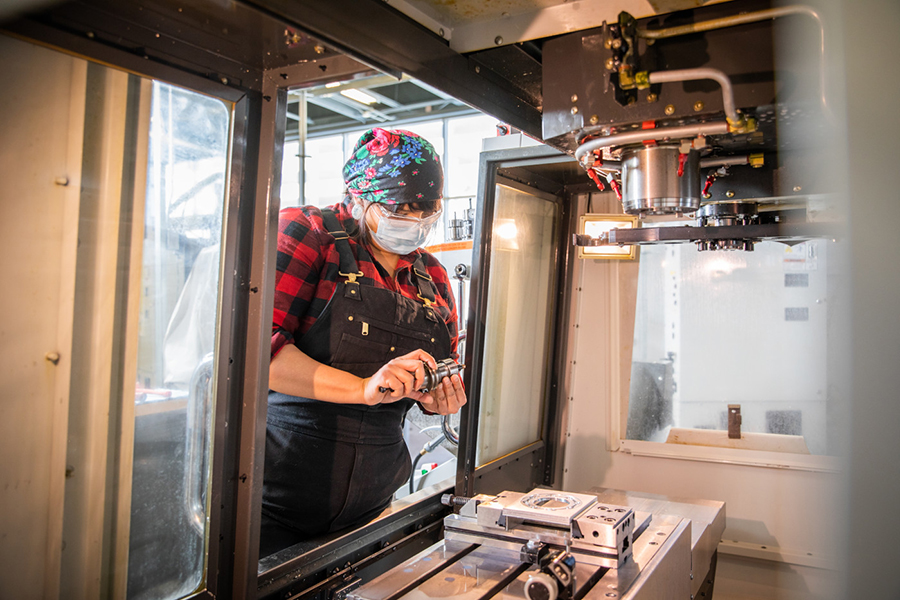Student sees wearing an orange shirt as “beautiful and powerful” show of solidarity
The National Day for Truth and Reconciliation and Orange Shirt Day, on Sept. 30, is a time to remember and honour the children, families and communities affected by residential schools. Wearing an orange shirt is a show of solidarity. This year, the shirts sold at shopATNAIT (with $10 from each one going to the Orange Shirt Society) were redesigned by Culinary Arts student Drea Halfe, from Saddle Lake, AB.
Introduced to arts and crafts by her mother, who taught her how to bead, Halfe began creating beaded earrings, ribbon skirts, shirts and jean jackets. She later started her own small business, Mikwan Designs, called that for her Cree name, to fund her schooling.
After sharing a few of her designs with staff at the Nîsôhkamâtotân Centre, where Aboriginal and non-Aboriginal students can gather to network, study and share their post-secondary learning experiences at NAIT, they asked if she would be interested in redesigning the previous iteration of their orange shirt.
That came as a surprise to Halfe. “[I’d] never done it before but I said, ‘Sure, I’ll try!’” she says.
Techlifetoday spoke with Halfe about her design, how she came to the job as a culinary student, and how we can all share the responsibility of reconciliation.
techlifetoday: Why did you want to take on the task of redesigning the shirt?

Halfe: At first, I wasn’t sure I was going to design this shirt or even do any interviews [about it]. I’m kind of quiet, and it was my husband who was supporting me and telling me, “You don’t know how your story can affect people and inspire, so even though you’re nervous, it’s important to do these interviews and share what you know.”
I don’t know much but I want to be involved. I want to be part of the community and I want to share our stories and learn more too. So it’s beautiful for me to be able to connect this way and be involved and to help support. Any little bit I can do, I’ll do it.
What was your inspiration for the design?
Having never designed anything like this before, I was looking at other ‘Every Child Matters' shirts, stickers and all kinds of different artwork. The handprint is pretty prominent from what I’ve seen. I was just looking at it, thinking how we’re all unique, like a handprint.
I wanted to include my family because they’re everything to me.
Me and my family did this little piece of art to hang on our walls, and we all put our handprints on it. My husband is Métis and I’m First Nation, and I wanted to include my family because they’re everything to me. So I took a picture of [my handprint] and I went around that. I put a little orange heart on there and wrote 'Every Child Matters.’
You’re a culinary student, so how did you accomplish redesigning the shirt?
There was a program I did out of Toronto … in digital [design]. It was just a free program and I signed up for it when I started beading. I thought it wouldn’t apply to me because I don’t paint, or draw or anything like that, but I do use lots of colours for beading, so I completed it.
Did you encounter any challenges during the design process?

There were quite a few because I was in school at seven in the morning and had my two kids: one in school and one was just learning how to walk. I was trying to do well in school, run the house and be the mom – and just not knowing how to start [designing the T-shirt]. There was a time crunch, too, because [the Nîsôhkamâtotân Centre] needed it at the beginning of March.
What are your thoughts on Truth and Reconciliation? What does Orange Shirt Day mean to you?
It’s a very special thing. Me and my husband participate in events on the day. He’s a fiddler and I jig. So we perform, and I’ve been asked to participate in markets around the community here and in Sherwood Park.
It’s beautiful to see that we’re all still here and we’re all still very strong.
It’s just important to share our culture and stories, and the hurt of what happened to us as a people. It’s beautiful to see that we’re all still here and we’re all still very strong, and on the day how many orange shirts we see in solidarity. It’s really beautiful and feels powerful.
What would you like to see people do on the day?
The responsibility of reconciliation shouldn’t only rest on the shoulders of the Indigenous. It belongs to all of us. A way to show support is to wear the orange shirt and come out to the events, as there are plenty on the day.
There’s different cultural showcases and people showing their work. I see people doing beading workshops, and music, and dancers and the drum. Show up and … open your mind enough to be willing to learn and be respectful. Sit with an Elder and offer the tobacco protocol to share their stories, and just listen.
How NAIT has responded to the Truth and Reconciliation Commission’s 94 calls to action

According to Reconciliation Education, the 94 Calls to Action are “actionable policy recommendations meant to aid the healing process in two ways: acknowledging the full, horrifying history of the residential schools system, and creating systems to prevent these abuses from ever happening again in the future.”
Following the release of the report, NAIT published its Aboriginal strategy, Connecting the Four Directions. Guided by the seven Grandfather teachings and ways of knowing and doing, the strategy is a resource for staff to work together to create meaningful change throughout their journey towards reconciliation.
Here are a few ways that NAIT and staff have responded to the calls to action:
- launched a new admissions pathway to address the systemic educational barriers for Indigenous students by providing a more culturally accessible way to apply for NAIT programs
- developed new processes around funding, including permitting tuition payment extensions for Indigenous learners to alleviate barriers to meeting payment deadlines from a third party, such as bands
- launched a sharing circle series called Pîkiskwetân (Let’s Talk), facilitated by the Nîsôhkamâtotân Centre, on Aboriginal perspectives and history
- created a new territorial land acknowledgement to demonstrate our shared understanding that NAIT is located on land that was, and continues to be, Treaty Six territory and that we recognize there is more to learn and more work to be done
- created new curriculum for the School of Health and Life Sciences. All students will take a course covering Indigenous health issues that includes the history and legacy of residential schools, the United Nations Declaration on the Rights of Indigenous Peoples, treaties and Indigenous rights, teachings and practices. This is skills-based training in intercultural competency, conflict resolution, human rights and anti-racism
- established the Four Directions Bursary in response to the call to action to create equitable opportunities for Aboriginal students to succeed in post-secondary
– NAIT Staff